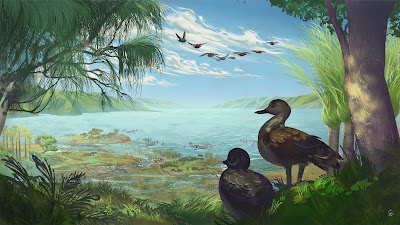 |
| Miotadorna catrionae Tennyson, Greer, Lubbe, Marx, Richards, Giovanardi & Rawlence, 2022 |
Abstract
We describe a new species of extinct duck, Miotadorna catrionae sp. nov. (Anatidae, Tadornini, Tadorninae), based on a right humerus from the Miocene lacustrine deposits of St Bathans, Otago, New Zealand. Principal component analysis reveals that the new taxon is distinguished by its large size and relative proportions. This is the eighth and largest species of duck described from the St Bathans fossil assemblage and further underscores the global importance of this site for understanding anatid evolution.
Keywords: Tadornini; Miotadorna catrionae sp. nov.; fossil; shelduck; lacustrine; Bannockburn formation
SYSTEMATICS
Class Aves Linnaeus, 1758
Order Anseriformes Wagler, 1831
Family Anatidae Leach, 1819
Subfamily Tadorninae Reichenbach, 1849: Shelducks
Tribe Tadornini Reichenbach, 1849
Genus Miotadorna Worthy, Tennyson, Jones, McNamara and Douglas, 2007
Miotadorna catrionae sp. nov. Tennyson, Greer, Lubbe, Marx, Richards, Giovanardi and Rawlence
Holotype: NMNZ S.47273, right humerus.
Type locality: Mata Creek Site 9, St Bathans, Central Otago, 44° 52.8288′ S, 169° 50.4162′ E. NZ Fossil Record File Number H41/f0122. Bannockburn Formation, late early–earliest middle Miocene (Burdigalian–Langhian global stage, Altonian local stage), 18.7–15.9 Ma.
Etymology: After N.J.R.’s mother Catriona Drummond (1954–2020) who inspired his love of natural history.
Suggested English vernacular name: Catriona’s Shelduck.
Diagnosis: Shelduck characterized by a robust humerus (142.5 mm long) with a wide proximal and a narrow distal end. Differs from all other anatid humeri from St Bathans in its larger size, which is comparable to that of a small goose, such as the Egyptian goose (Alopochen aegyptiaca) (e.g., NMNZ OR.29470: humerus length 142.2 mm). It specifically differs from Miotadorna sanctibathansi—the largest previously described anatid from St Bathans—in having a longer, more tapered humerus with a wider proximal end but a similar-sized distal end (Figure 2B, Appendix A). Resembles M. sanctibathansi in having an elongate shaft, a prominent capital shaft ridge directed towards the ventral side of a markedly elevated dorsal tubercle, a relatively narrow dorsal pneumotricipital fossa that does not undercut the humeral head, an elongate deltoid crest that extends well distal of the bicipital crest, and in having the attachment of the superficial pronator muscle located cranial of centre on the ventral face.
Alan J. D. Tennyson, Liam Greer, Pascale Lubbe, Felix G. Marx, Marcus D. Richards, Simone Giovanardi and Nicolas J. Rawlence. 2022. A New Species of Large Duck (Aves: Anatidae) from the Miocene of New Zealand. Taxonomy. 2(1); 136-144. DOI: 10.3390/taxonomy2010011
Something old, something new: meet St Bathans newest fossil duck
sciblogs.co.nz/lost-worlds/2022/03/10/something-old-something-new-meet-st-bathans-newest-fossil-duck


